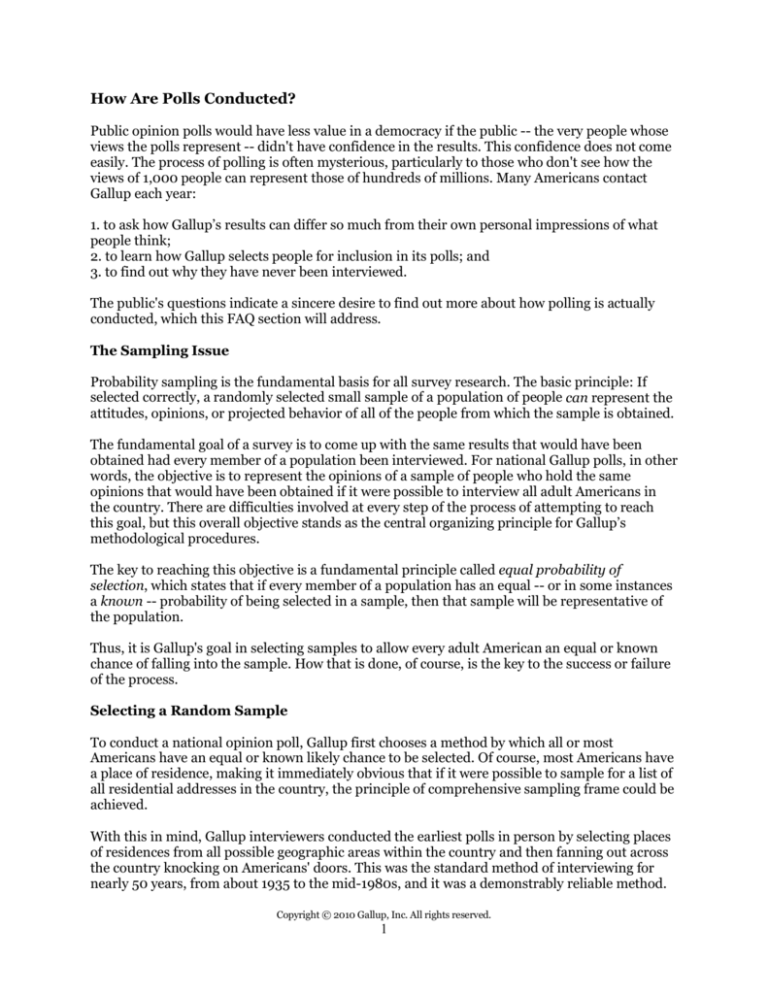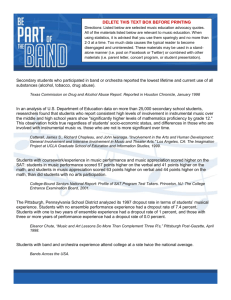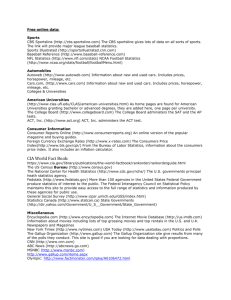
How Are Polls Conducted?
Public opinion polls would have less value in a democracy if the public -- the very people whose
views the polls represent -- didn't have confidence in the results. This confidence does not come
easily. The process of polling is often mysterious, particularly to those who don't see how the
views of 1,000 people can represent those of hundreds of millions. Many Americans contact
Gallup each year:
1. to ask how Gallup’s results can differ so much from their own personal impressions of what
people think;
2. to learn how Gallup selects people for inclusion in its polls; and
3. to find out why they have never been interviewed.
The public's questions indicate a sincere desire to find out more about how polling is actually
conducted, which this FAQ section will address.
The Sampling Issue
Probability sampling is the fundamental basis for all survey research. The basic principle: If
selected correctly, a randomly selected small sample of a population of people can represent the
attitudes, opinions, or projected behavior of all of the people from which the sample is obtained.
The fundamental goal of a survey is to come up with the same results that would have been
obtained had every member of a population been interviewed. For national Gallup polls, in other
words, the objective is to represent the opinions of a sample of people who hold the same
opinions that would have been obtained if it were possible to interview all adult Americans in
the country. There are difficulties involved at every step of the process of attempting to reach
this goal, but this overall objective stands as the central organizing principle for Gallup’s
methodological procedures.
The key to reaching this objective is a fundamental principle called equal probability of
selection, which states that if every member of a population has an equal -- or in some instances
a known -- probability of being selected in a sample, then that sample will be representative of
the population.
Thus, it is Gallup's goal in selecting samples to allow every adult American an equal or known
chance of falling into the sample. How that is done, of course, is the key to the success or failure
of the process.
Selecting a Random Sample
To conduct a national opinion poll, Gallup first chooses a method by which all or most
Americans have an equal or known likely chance to be selected. Of course, most Americans have
a place of residence, making it immediately obvious that if it were possible to sample for a list of
all residential addresses in the country, the principle of comprehensive sampling frame could be
achieved.
With this in mind, Gallup interviewers conducted the earliest polls in person by selecting places
of residences from all possible geographic areas within the country and then fanning out across
the country knocking on Americans' doors. This was the standard method of interviewing for
nearly 50 years, from about 1935 to the mid-1980s, and it was a demonstrably reliable method.
Copyright © 2010 Gallup, Inc. All rights reserved.
1
Gallup polls across the 12 presidential elections held between 1936 and 1984 were highly
accurate, with the average error in Gallup's final estimate of the election being less than three
percentage points.
It became obvious over time that household sampling with in-home interviewing had problems.
For one thing, it was increasingly expensive. Americans became increasingly resistant to
allowing interviewers to come into their homes to conduct surveys. And the need for rapidly
gathered data made the in-home interview procedure less and less attractive.
Gallup then turned its attention to the telephone. By 1986, a sufficient proportion of American
households had at least one telephone to make telephone interviewing a viable and substantially
less expensive alternative to the in-person method. By the end of the 1980s, Gallup was
conducting the vast majority of its national surveys by telephone.
Another important change was becoming obvious by the mid- to late 2000s: the increasing use
of cell phones by Americans. As a result, by 2008, Gallup had shifted its interviewing to include
traditional landline and cell phone sampling. Today, with increasing shifts in communication
that may eventually move some Americans beyond any type of phone toward texting and written
communication, there has been increased attention on the part of survey professionals to the
possible benefits of a move back to “old-fashioned” residential, address-based sampling.
For now, however, the vast majority of Gallup surveys intended to represent the national
population are based on interviews conducted by landline and cell telephones. This method
builds off of the central assumption that most Americans still either live in a residence with a
telephone or own a personal cell phone. So, reaching people on their telephones is the starting
place for current national surveys.
Procedurally, Gallup includes several steps in putting together its poll with the objective of
letting every American household and every American adult have an equal chance of falling into
the sample.
Initially, Gallup clearly identifies and describes the population that a given poll is
attempting to represent.
If Gallup was polling about baseball fans on behalf of the sports page of a major newspaper, the
target population might be all Americans aged 18 and older who say they are fans of the sport of
baseball. If the poll were being conducted on behalf of Major League Baseball, however, the
target audience the client requires might more specific, such as people aged 12 and older who
watch at least five hours of MLB games on television, or in-person, each week. And so on.
In the case of Gallup polls that track elections and major political, social, and economic
questions of the day, the target audience is generally referred to as "national adults." Strictly
speaking, the target audience is all adults, aged 18 and older, living in United States. In effect,
the population represented becomes all Americans aged 18 and older who have a telephone.
Next, Gallup chooses or designs a method to sample the target population
randomly.
The findings from Gallup’s telephone surveys are based on Gallup’s standard national telephone
samples, consisting of directory-assisted random-digit telephone samples using a proportionate,
stratified sampling design. This complicated process starts with a computerized list of all
Copyright © 2010 Gallup, Inc. All rights reserved.
2
telephone exchanges in America, residential and cellular, along with estimates of the number of
phones these exchanges have attached to them. The computer, using a procedure called
random-digit-dialing (RDD), actually creates phone numbers from those exchanges and then
generates telephone samples from those. In essence, this procedure creates a list of all possible
household phone numbers and all possible cell phone numbers in America and then selects a
subset of numbers from that list for Gallup interviewers to call.
It's important to go through this complicated procedure for two reasons. A significant
percentage of residential phones are unlisted. And, almost all cell phone numbers are unlisted in
the sense that there is no phone book or other comprehensive listing of them. The random-digitdial procedure allows telephone exchanges to be the main medium of sampling, with the digits
of particular phone numbers added randomly.
Selecting the Individual to Be Interviewed
Within each contacted household reached via landline, an interview is sought with the adult 18
years of age or older living in the household who has had the most recent birthday. (This is a
method pollsters commonly use to make a random selection within households without having
to ask the respondent to provide a complete roster of all adults living in the household). Gallup
does not use the same respondent selection procedure when making calls to cell phones because
they are typically associated with one individual rather than shared among several members of a
household.
The Number of Interviews or Sample Size Required
One key question faced by Gallup statisticians is how many interviews does it take to provide an
adequate cross section of Americans? The answer is not many -- if the respondents to be
interviewed are selected entirely at random, giving every adult American an equal or known
probability of falling into the sample. The typical sample size for a Gallup poll, either a
traditional stand-alone poll or one night’s interviewing from Gallup’s Daily tracking, is 1,000
national adults.
Broadly speaking, the actual number of people that need to be interviewed for a given sample is
to some degree less important than the soundness of the fundamental equal probability of
selection principle. This is something many people find hard to believe, if respondents are not
selected randomly, Gallup could have a poll with a million people and still be significantly less
likely to represent the views of all Americans than a much smaller sample of 1,000 people
selected randomly.
To be sure, there is some gain in sampling accuracy that comes from increasing sample sizes.
Using common sense and sampling theory, a sample of 1,000 people is most likely going to be
more accurate than a sample of 20. Surprisingly, however, once the survey sample approaches
500, 600, 700, or more, there are fewer and fewer accuracy gains that come from increasing the
sample size. Gallup and other major organizations use sample sizes of between 1,000 and 1,500
for standard surveys because they provide a solid balance of accuracy against the increased
economic cost of larger and larger samples. If Gallup were to use a sample of 4,000 randomly
selected adults each time it did a poll, the increase in accuracy over a well-done sample of 1,000
would be minimal, and for sample accuracy reasons, would not justify the increase in cost.
Copyright © 2010 Gallup, Inc. All rights reserved.
3
There are, however, other reasons why large sample sizes can be important including, in
particular, the ability to subset the sample into small population segments for analysis purposes.
This is the great advantage provided by aggregates of Gallup’s Daily tracking samples.
Statisticians over the years have developed specific ways of measuring the accuracy of samples -so long as the fundamental principle of equal or known probability of selection is adhered to
when the sample is drawn.
For example, with a sample size of 1,000 national adults (derived using careful random selection
procedures), the results are highly likely to be accurate within a margin of error of ±4 percentage
points. Thus, if a president’s approval rating is 50%, the margin of error indicates that the true
rating (that is, the rating that would be obtained had Gallup interviewed every adult in
American) is likely to be between 54% and 46%. It is unlikely to be higher or lower than that.
To be more specific, the laws of probability say that if Gallup was to conduct the same survey
100 times, asking people in each survey to rate the job President X is doing as president, in 95
out of those 100 polls, his rating would be between 46% and 54%. In five of those surveys, his
rating would be higher or lower than that due to chance error.
If Gallup increases a poll sample size to 2,000, the results would then be accurate within ±2% of
the underlying population value, a gain of two percentage points in terms of accuracy, but with a
100% increase in the cost of conducting the survey. These are the cost value decisions that
Gallup and other survey organizations make when they decide on sample sizes for their surveys.
Weighting the Sample
After Gallup collects and processes survey data, each respondent is assigned a weight so that the
demographic characteristics of the total weighted sample of respondents match the latest
estimates of the demographic characteristics of the adult population available from the U.S.
Census Bureau. Gallup weights data to census estimates for gender, race, age, educational
attainment, and region.
Copyright © 2010 Gallup, Inc. All rights reserved.
4








